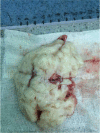Bladder leiomyoma presenting as dyspareunia: Case report and literature review
- PMID: 27428187
- PMCID: PMC4956781
- DOI: 10.1097/MD.0000000000003971
Bladder leiomyoma presenting as dyspareunia: Case report and literature review
Abstract
Introduction: Leiomyoma of the bladder is a rare tumor arising from the submucosa. Most patients with bladder leiomyoma may present with urinary frequency or obstructive urinary symptoms. However, there are a few cases of bladder leiomyoma coexisting with uterine leiomyoma presenting as dyspareunia. We herein report an unusual case of coexisting bladder leiomyoma and uterine leiomyoma presenting as dyspareunia.
Case presentation: A 44-year-old Asian female presented to urologist and complained that she had experienced dyspareunia over the preceding several months. A pelvic ultrasonography revealed a mass lesion located in the trigone of urinary bladder. The mass lesion was confirmed on contrast-enhanced computed tomography (CT). The CT scan also revealed a lobulated and enlarged uterus consistent with uterine leiomyoma. Then, the biopsies were then taken with a transurethral resection (TUR) loop and these biopsies showed a benign proliferation of smooth muscle in a connective tissue stroma suggestive of bladder leiomyoma. An open local excision of bladder leiomyoma and hysteromyomectomy were performed successfully. Histological examination confirmed bladder leiomyoma coexisting with uterine leiomyoma.
Conclusion: This case highlights a rare presentation of bladder leiomyoma, dyspareunia, as the chief symptom in a patient who had coexisting uterine leiomyoma. Bladder leiomyomas coexisting with uterine leiomyomas are rare and can present with a wide spectrum of complaints including without symptoms, irritative symptoms, obstructive symptoms, or even dyspareunia.
Conflict of interest statement
The authors have no conflicts of interest to disclose.
Figures




References
Publication types
MeSH terms
LinkOut - more resources
Full Text Sources
Other Literature Sources
Medical

